|
On the eve
of a partial solar eclipse on August 11, 2018, which would be seen
across most of the Northern Hemisphere on Earth, some unknown crop
artists drew the beautiful picture of a “planetary gearbox”, which seems
to contain three “planetary” or “epicyclic” gears.
This was
clearly an artistic metaphor for certain “gear-like” motions of our Sun
and Moon in Earth’s sky, which give rise to solar or lunar eclipses on a
fairly regular basis, several times each year. Yet what else might they
have subtly been trying to tell us?
One day
before a partial solar eclipse which would be seen across most of the
Northern Hemisphere on Earth (see
eclipse-2018-august-partial-solar-eclipse-watch-online-again),
some
unknown crop artists drew on August 10, 2018 a beautiful field image on
top of Etchilhampton Hill, near the small village of Mixon. This field
image is shown in the slide below:
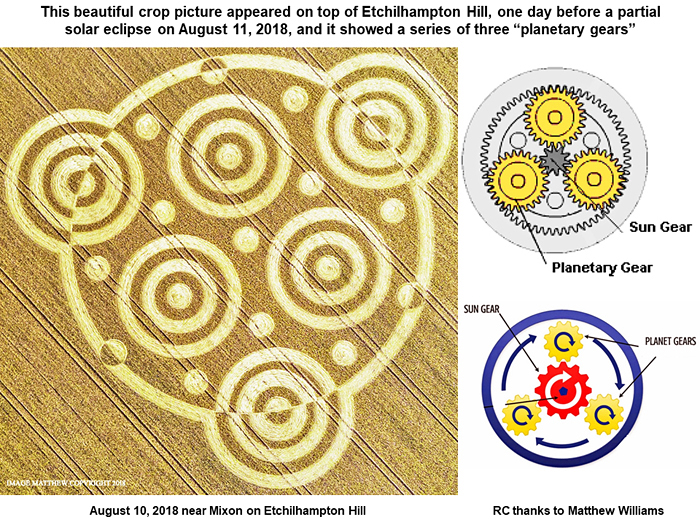
Right away
we can see that their crop picture seems to represent what is known as a
“planetary gearbox” (see
Epicyclic_gearing). Within such a device, several different
mechanical gears turn around one another, in the same way that
astronomers on Earth once used “epicycles” to explain how the Sun, Moon
or other bright heavenly objects seem to move through Earth’s night sky.
In the next
slide, we can see that 13 small circles which were also drawn there (10
fully flattened, 3 half-flattened) seem to resemble the mechanical
“ball bearings”, which would be needed to help these three
“planetary gears” turn easily around a central axis
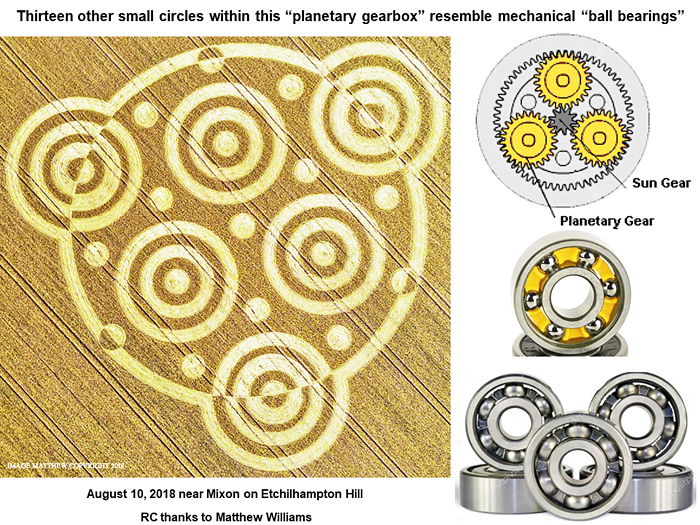
This was all
just a metaphor, of course, for what would be seen in Earth’s sky on the
next day of August 11, namely a partial solar eclipse!
Two weeks
earlier at Hackpen Hill on July 29, the crop artists drew a mechanical
“compound gear” with three different levels, as a metaphor for a new
kind of lunar calendar, just after a total lunar eclipse on July 27,
2018 (see
hackpenhill 2018
or
hackpen hill 3 articles ).
So although we have not yet met these mysterious crop artists
face-to-face, they do seem very consistent from week to week in their
choice of artistic metaphors!
A clever
metaphor for solar-system astronomy
What might
their new field image of a “planetary gearbox” mean in terms of real
astronomy? So far as I can tell, it seems to describe how our Sun
appears to move relative to the distant fixed stars, as seen by an
observer looking up at his local night sky on Earth. We call the
imaginary plane of such apparent motion the “solar ecliptic”:
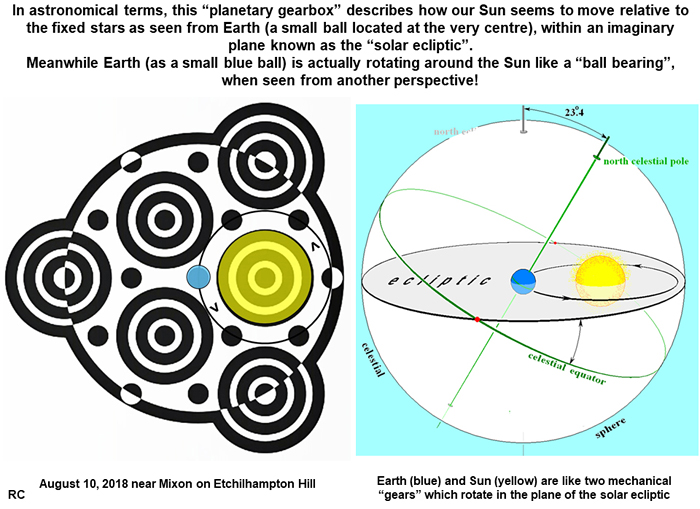
Meanwhile
planet Earth is actually rotating around our Sun once in every solar
year, when viewed from another perspective. “Gears within gears”,
one might say!
The overall
diagram which was drawn in crops shows three different
internal “planetary gears” for our Sun (each a large ringed shape), plus
six small “ball bearings” to represent the orbital motion
of planet Earth, around each of those three large ringed shapes. So the
overall period of time which has been drawn here seems possibly to be 3
full orbits of Earth around our Sun, or 3 solar years.
Let’s watch
a movie to understand such gear-like motions more clearly
For those
people who might not understand the two gear-like motions just
described, I have included a small movie for increased clarity. As we
stand on planet Earth (blue), and look at our Sun (yellow) over the
course of a year, we seem to see that our Sun is “moving” along the
ecliptic past distant, fixed stars:
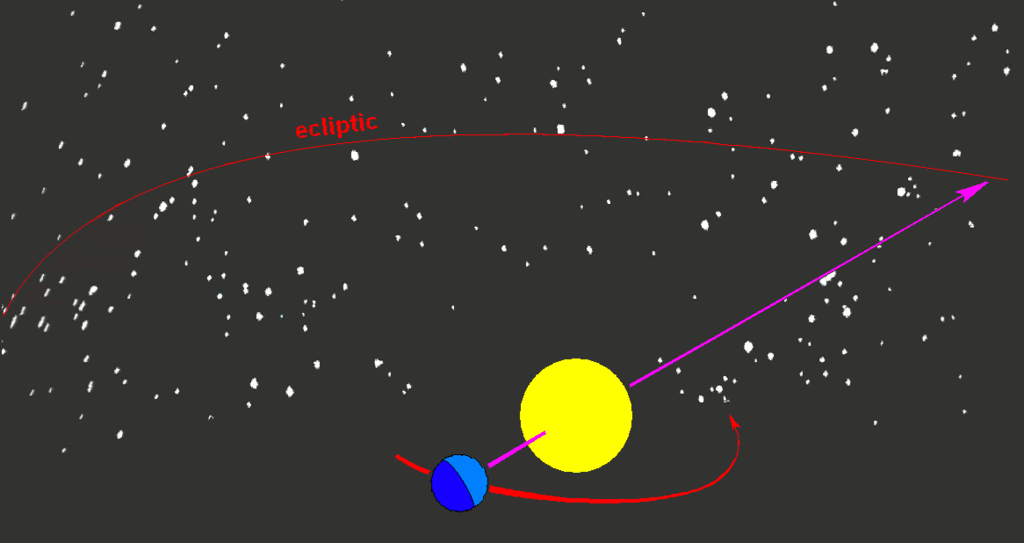
That is true
in our local “stationary” perspective. Yet when we look at our solar
system from a more distant outside perspective, we would see our Sun as
almost stationary, while a small (blue) planet Earth rotates around it
(like a “ball bearing”).
Our Sun is
often represented by a large, yellow, ringed symbol in star maps
Our Sun is
often represented by a large, yellow, ringed symbol in star maps. The
standard symbol for our “Sun” (see below) thus closely resembles each of
three large, multiply-ringed motifs which were drawn in crops near Mixon
on August 10:
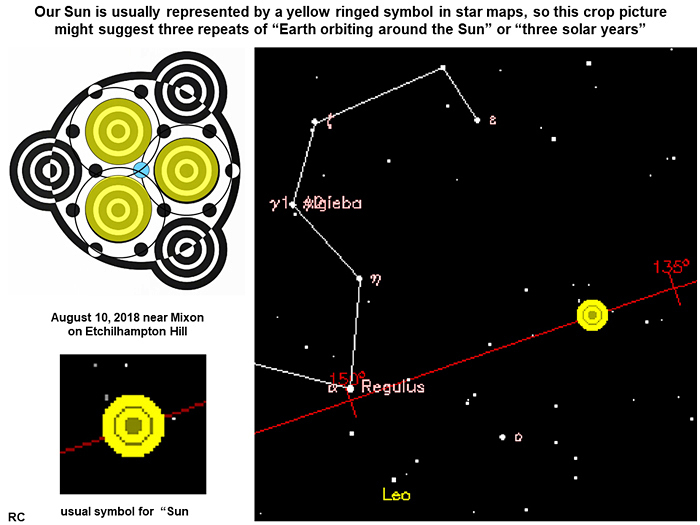
As a corollary to this plausible
interpretation, the Mixon crop picture might be meant to suggest “three
full orbits of planet Earth” (a small circle shaded in blue) around our
“Sun” (each a large ringed circle shaded in yellow), or “three solar
years”.
Each symbol
for our Sun in this crop picture might likewise be regarded
metaphorically as a kind of “planetary gear”, which rotates in the plane
of the ecliptic around a central “celestial pole”. Meanwhile planet
Earth revolves around each “Sun” motif in its yearly orbit, like a
metaphorical “ball bearing” from a “planetary gearbox”.
Creating
solar or lunar eclipses by a “planetary gearbox”, whenever our Moon
crosses the plane of the ecliptic
By taking
their metaphor of a “planetary gearbox” one step further, we can
understand how a slightly-skewed orbit for our Moon, which lies 5o
off the plane of the solar ecliptic, may be able to create solar or
lunar eclipses two times in every year.
When the
skewed orbit of our Moon crosses the plane of the solar ecliptic, and
lies temporarily between Earth and Sun (for a new Moon), then the shadow
which it creates for light from the Sun may extend through space onto
the sunlit side of planet Earth, and thereby make it appear that our Sun
has gotten slightly darker, or has been “eclipsed”:
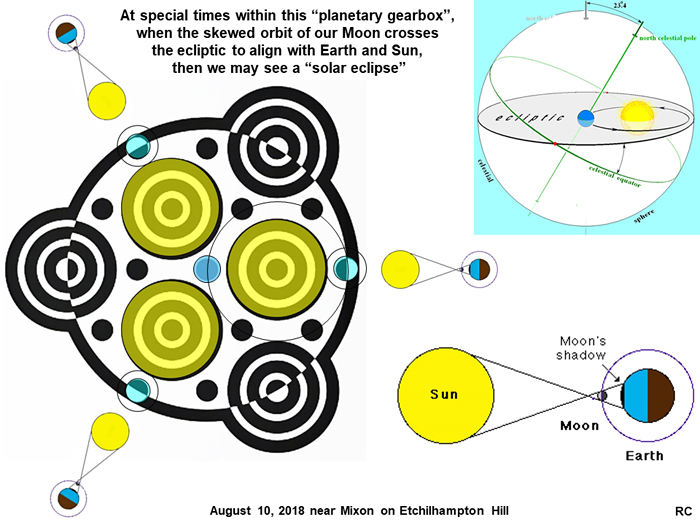
Likewise
when the skewed orbit of our Moon crosses the plane of the solar
ecliptic, and lies temporarily on the far side of the Earth from the Sun
(for a full Moon), then the shadow which planet Earth creates for light
from the Sun may extend through space onto the sunlit side of the Moon,
and thereby make it appear that the Moon has gotten slightly darker, or
has been “eclipsed”:
The working
of astronomical bodies in our solar system is literally akin to a
“clock” with “planetary gears”, which thereby enables the accurate
prediction of rare eclipses far into the past or future.
This is also
why they drew a half-shaded, small circular symbol for “planet Earth” in
three places along the outer perimeter of this crop picture, because
that it is where both Earth and Moon must lie exactly in the plane of
the solar ecliptic (the largest broad circle from this crop picture), as
a pre-condition for any eclipse to occur.
Crescent-shaped shadows of our Moon move along the face of the Earth,
during a partial or total solar eclipse
Finally
whenever a solar eclipse does occur, such as on August 11, 2018, the
shadow of our Moon on the Earth may create crescent-shaped shadows of a
unique but predictable appearance, that will be different for every
eclipse:
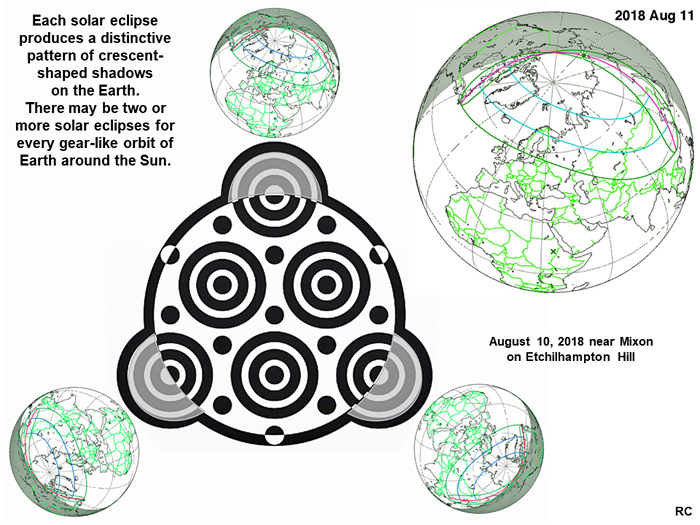
Such
crescent-shaped shadows, along with long curved contours of
radial-shadow-intensity, were drawn around the outside of the Mixon crop
picture in three different places.
Are the crop
artists just trying to teach us basic astronomy, or do they have some
other subtle message in mind?
The crop
picture drawn at Mixon suggests an apparent time-period of three
calendar years, presumably from August of 2018 to August of 2021. During
this period of time, there will be seven (7) partial, total or annular
solar eclipses: the first on August 11, 2018, the next on January 6,
2019, and so on until the seventh on June 10, 2021.
In the
landscape where this new crop picture was drawn, we can see a large
number “7”, along with the schematic image of a human-looking “serpent”
with “eyeglasses”, who seems to be “thinking about eclipses”. From
another perspective 180o away, we can see the schematic image
of a “lion” for the constellation Leo, close to where this latest
partial solar eclipse took place. We will discuss both of those
interesting observations in the second (brief) part of this article.
This 2018
crop picture near Mixon also resembles a famous crop picture near
Ammersee, Germany on July 18, 2014, which seemed to show a “three-lobed
spaceship” emerging from a “spacetime wormhole” (see
Ammersee 2014l ).
Whether they are trying to give us some kind of eclipse-dated prediction
for that event, or whether it is just an artistic coincidence between
crop pictures made in Germany and those in England, would be hard to
say.
Appendix 1.
How many solar eclipses will there be over the next three years, from
August of 2018 to August of 2021? And might the crop artists be
“counting time” in terms of the number of solar eclipses remaining,
until they arrive on Earth or something else important happens?
As mentioned
near the end of the main article above, this crop picture seems to
suggest an overall time-period of three solar years from August
of 2018 to August of 2021. Our small, blue, planet Earth will orbit
around the Sun three times during that period, while our Sun will move
circularly around the solar ecliptic, metaphorically like for the rotary
motion of a “large gear” (the Sun) and a small “ball bearing” (Earth) in
a “planetary gearbox”.
During this
upcoming three-year period, there will be seven solar eclipses
visible from Earth, whether of the partial, total or annular variety:

The Mixon
crop picture appeared on August 10, 2018, just one day before the first
solar eclipse out of seven on that list. How do we know that such
concerns might be significant?
Well, when
we study the landscape close to this new crop picture using Google
Earth, with “West-Southwest up”, we can see the image of a human
“serpent” who is wearing “glasses”, and looking to his left at a large
number “7” in the landscape (labelled in yellow):
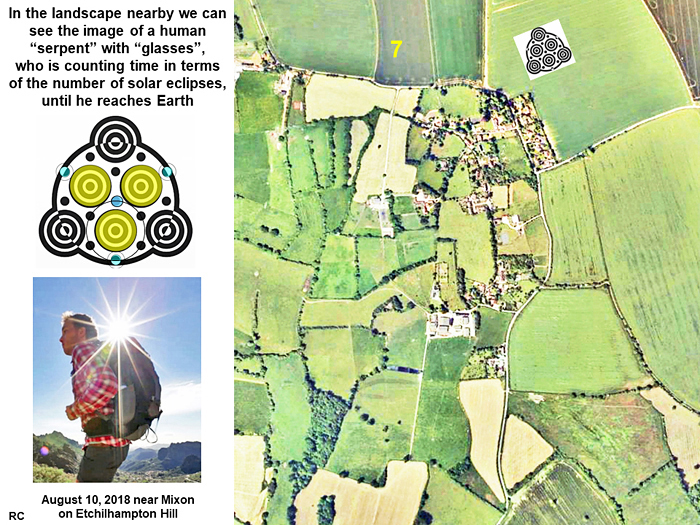
The Mixon
crop picture was drawn just behind his “head”, or slightly above and to
the right. This “serpent” also seems to be wearing a small “backpack”,
which some traveller might wear, for example, while hiking through the
mountains.
How long
will it take for this human “serpent” to get where he is going? “Many
moons!”, a native American might say. Yet our “serpent” friend seems
to be thinking more about “3 solar years” (shaded In yellow and blue on
the left), or alternatively “7 solar eclipses”.
A similar
field image was drawn near Jesuino Marcondes in Brazil on August 3,
2018. There we could see a “bearded man” in the landscape, who seemed to
be “navigating by the Sun”, He was also waiting for a partial solar
eclipse to take place 8 days later on August 11, 2018 (see
Jesuino articles ).
Two other
interesting aspects of the landscape near this Mixon crop picture should
be mentioned. First, the small round “eye” of that human-like “serpent”,
when it is studied closely using Google Earth at latitude 51.340o
N, longitude 1.938o W (with “North up”), resembles the image
of a “smiley face”.
Secondly,
when we study the Mixon crop picture and its surrounding landscape from
a much broader perspective, using Google Earth centred approximately on
latitude 51.338o N, longitude 1.925o W (with “West
up”), we can see that this human-like “serpent” seems to be coming down
from space, while metaphorically “riding a white horse”.
He also
seems to be getting ready to “shake hands” with someone who will meet
him after he lands, just like we can see from a similar image which was
carved into stone, 2000 years ago in central America (see
mexico olmec 10.jpg).
So today on
August 13, 2018, there may be slightly less than three years left to go,
or six solar eclipses, until these crop-suggested events take place.
Could any of this speculation be true? Will the legendary “feathered
serpent”, also known as “Quetzalcoatl” or “Kukulkan”, really return to
Earth?
In this
final slide, we compare two related crop pictures from near Ammersee,
Germany on July 18, 2014, or near MIxon, England on August 10, 2018.
There are two possible ways by which to overlap these two crop pictures,
as shown on the right-hand side of the slide below. In each case, they
fit together nicely:
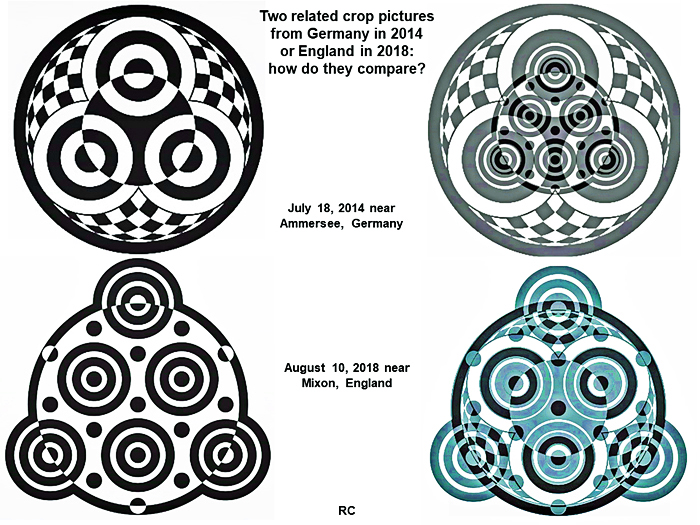
A
“three-lobed spaceship” seems to be emerging from a “spacetime wormhole”
in the crop picture from Germany 2014. Now in 2018, that “three-lobed
spaceship” shows at its centre (see the blue image at lower right) a
schematic image of our “Sun and Earth” over three full orbits, or three
solar years.
Perhaps that
is when we will see it? In August of 2016, we likewise saw drawn near
Ansty a large and complex crop picture which said “MOTHERSHIP” (twice),
using two sets of ten strange alphabet-symbols around the outside.
Three
different strategies were used at Mixon to code subtly for the number
“7”
The number
“7” (for seven solar eclipses between August 2018 and
August 2021) was suggested by the Mixon crop picture in three different
ways. First we can see a large number “7” in the
landscape close to where it was drawn, as was shown above.
Secondly,
the number of sub-divisions in various small motifs from
the Mixon 2018 crop picture numbered either 1, 2, 5 or 6. Meanwhile the
number of sub-divisions in similar small motifs from the Ammersee 2014
crop picture (shown above) numbered either 3 or 4. These two crop
pictures therefore combine to produce a continuous mathematical
series of 1, 2, 3, 4, 5, 6 whose next number would be “7”.
Thirdly and
most cleverly, the geometrical structure of the Mixon crop picture codes
quite obviously for a number “7”, if we analyse it in terms of
Pascal’s Triangle:
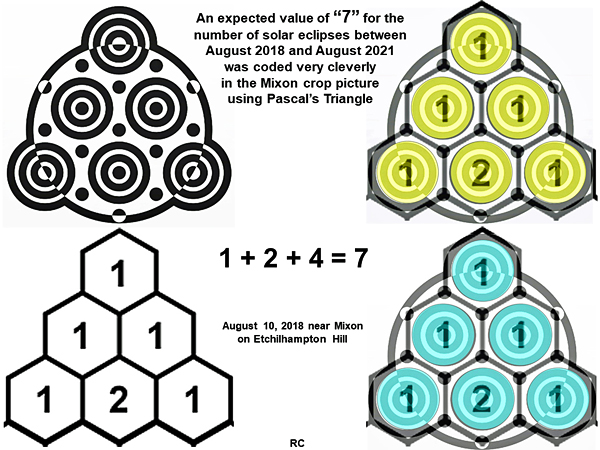
Our human
“serpent” friend apparently saw a large number “7” in the
landscape near Mixon, then drew a new crop picture nearby which was
based on the first three rows of Pascal’s Triangle, along with a
hexagonal-cell shape, in order to calculate it as the sum of (1) + (1 +
1) + (1 + 2 + 1). It was truly a work of both mathematical and artistic
genius!
Red Collie
(Dr. Horace R. Drew) |